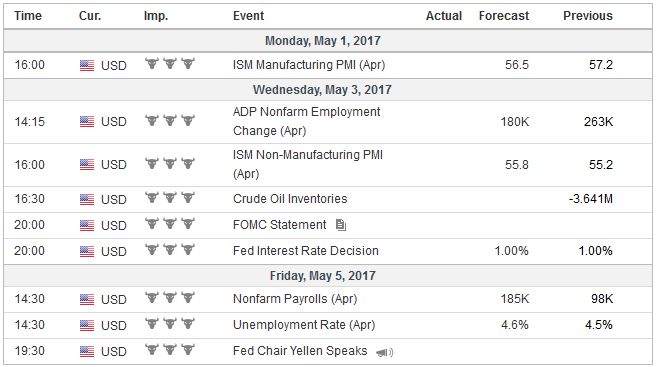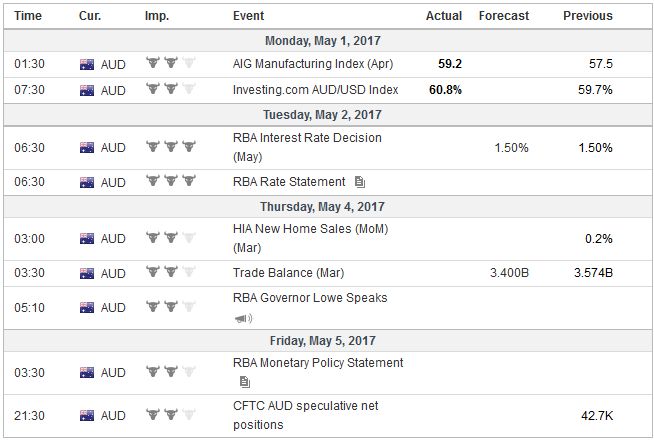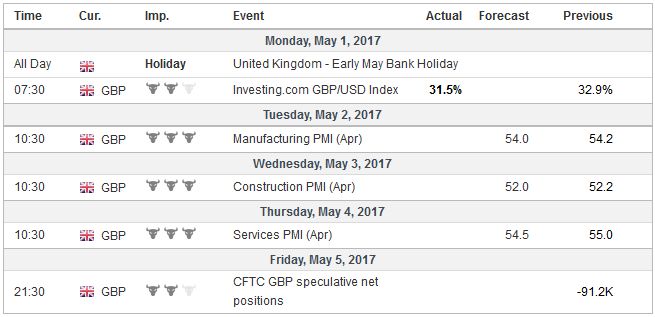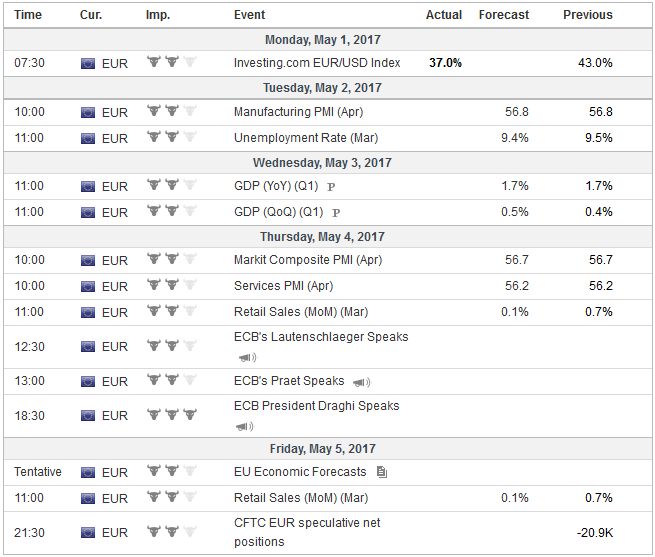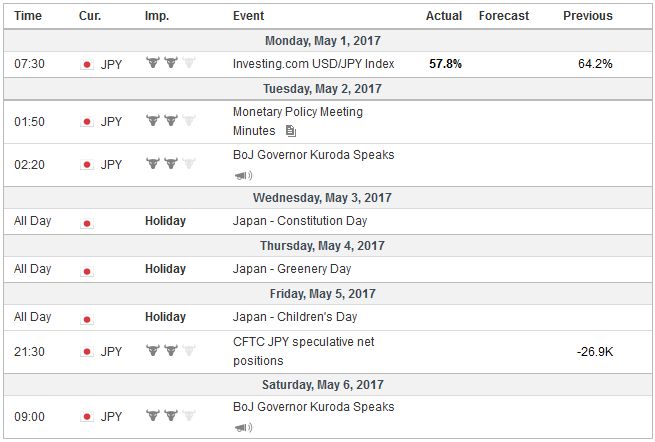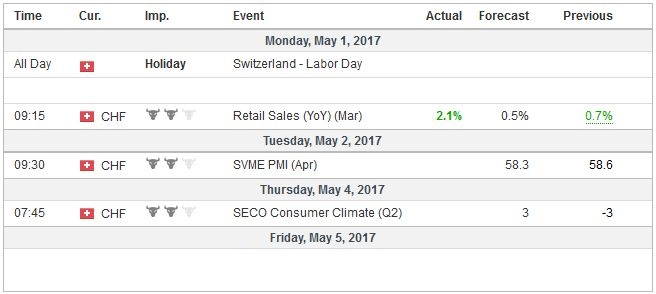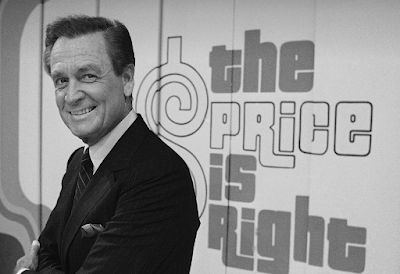Summary:
US jobs and auto sales data may be more important than the FOMC meeting.
Norway and Australia’s central bank meets. Neither is expected to change policy.
All three large countries that reported Q1 GDP figures last week – US, UK, France – disappointed expectations.
A Federal Reserve meeting always draws market interest, as investors are on guard for policy signals. However, the statement from this week’s meeting is likely to be devoid of new information. It may tweak its economic assessment as the recent data warrants, including the continued improvement of the labor market, and better capital investment.
Inflation, it will likely note, is near target. In the quarterly calculation of GDP, the core PCE deflator accelerated to 2.0%., though the monthly estimate is a little lower. The continued gradual removal of accommodation will be justified, though there is no reason to expect an explicit signal that it intends to hike rates at the June meeting. With the cycle underway, there is not need for that level of forward guidance. It is also unreasonable to expect fresh revelations about the balance sheet strategy. Discussions are ongoing, and there is not need for any decision yet.
United StatesThe Federal Reserve may be a bit disappointed with the preliminary estimate for Q1 GDP, but it does not appear to put much stock in the quarterly growth numbers which a subject to statistically significant revisions and is particularly noisy. Also, there are some elements of GDP that are not necessarily subject to monetary policy, like government spending, inventory accumulation, and foreign demand. This measure, private final domestic purchase rose 2.2%, which is probably understood to be a little above trend. Moreover, there is a good reason to expect that growth is already re-accelerating. Part of the weakness in consumption was a fluke due to warmer weather and utility usage. There are two reports this week that may impact expectations about the June FOMC meeting more than the May statement. Auto sales and employment were soft in March. They can be expected to bounce back smartly in April as the impact from a winter storm reverses. A recovery in auto sales will likely set the tone for retail sales more broadly. Non-farm payroll growth is expected to snap back toward its underlying trend, and anything above 200k at this stage of the cycle must be considered robust. Before the sub-100k increase in March, the six-month and 12-month averages straddled 190k. Average weekly hours may tick up to 34.4 hours. It has been averaging 34.4 hours for the last 12 and 24 months. Remarkably, and with little fanfare, the US economy has achieved what the French state struggled to do, and that is a 35 hour work week. A 0.3% increase in April average hourly earnings will maintain the year-over-year pace of 2.7%, which is what it has averaged over the past six and 12 months. The modicum improvement is evident in coming it to the 24 month average of 2.5%. The Employment Cost Index was reported before the weekend, and it is thought to be the Fed’s preferred measure of wage inflation. It accelerated in Q1 to 0.8% from 0.5% in Q4 16. It is the fastest pace since the end of 2007. The wage component of the ECI is up 2.3% year-over-year. The Beige Book also picked up wage pressures. The trend strengthens the case for a gradual adjustment of Fed policy. |
Economic Events: United States, Week May 01 |
AustraliaThe Federal Reserve is not the only game in town. The Reserve Bank of Australia and Norway’s Norges Bank meet. Neither is expected to change rates. Down under, has not a reason to change its neutral stance. Since the RBA met last the labor market improved, vehicle sales picked-up, and Q1 CPI accelerated over Q4 16. Regulatory (macro-prudential) already may be having an impact in the housing market. Many economists continue to look for the RBA to ease later this year, but something must change first. There is less doubt the Norges Bank is on hold through this year, barring some significant shock. After falling sharply, prices pressures may be stabilizing. On a trade-weighted basis, the krone has depreciated about 2.75% year-to-date. |
Economic Events: Australia, Week May 01 |
United KingdomThe Bank of England does not meet this week, but rather May 11. However, this week’s PMI readings will likely reinforce the idea that the MPC is on hold. Forbes dissented at the previous meeting in favor an immediate hike, but she is unlikely to have convinced any of her colleagues (and her term is almost up). The PMIs are expected to be softer, but nothing dramatic. The past decline in sterling and the previous increase in energy prices are still working their way through the system. That means that risk on inflation is still on the upside. The MPC will view it as likely transitory. The currency impact and jump in energy prices will drop out of the calculation. Since the middle of March, sterling has appreciated by 4.5% on a trade-weighted basis, while interest rates have softened slightly and the equity market has rallied (FTSE 250 is up about 3.5%). After softening in earlier in April, financial conditions back where they spent the past six months. |
Economic Events: United Kingdom, Week May 01 |
EurozoneThe ECB met last week. Draghi recognized the optimism conveyed in surveys and noted that downside risks emanated primarily from abroad. Aggregate growth is not a problem, even though the surveys probably are running ahead of the actual situation. Growth in the first three months may disappoint the 0.5% median forecast in the Bloomberg survey. The three big economies that reported Q1 GDP at the end of last week, the US, the UK, and France, all were softer the expected. Eurozone growth has been remarkably steady. Consider that over the past four, eight, and 12 quarters, growth has averaged 0.45%, 0.46%, and 0.43% respectively. The ECB meeting and Draghi’s comments undercut much of the remaining interest in the final PMI readings after the flash report. Barring a significant shock now, there is only one thing that is important, and that is measures of inflation. The day after the ECB meeting the preliminary estimate of April consumer prices was reported. It jumped more than anticipated, with the core rate spiking to 1.2% from 0.7%. It matches the strongest pace in nearly four years. The data appears to be skewed by the Easter holiday, and often such seasonal spikes are retraced. Investors may have to wait until late May before getting a clean read on CPI. The ECB continued its line that kept open the possibility of providing more accommodation if needed, but no one believes it is true. There is speculation that this could change in June. Even if it does, it is a minor step that merely confirms what investors already know. Some creditors at the ECB want to consider raising the deposit rate or exiting some of the unorthodox measures early. Now it may push for a change in the balance of risks and/or drop reference to rates moving lower. The June meeting, at which the staff presents updated forecasts, will be held on June 8, three days before the first round of the French parliamentary elections (Macron’s party is a micron, it is a party of one, with no other members of parliament). It is the same day at the British elections and a few days before the FOMC meeting (June 14). The second round of the French election will be held on June 18. |
Economic Events: Eurozone, Week May 01 |
JapanWe remain struck by the pace of Japanese investors selling foreign bonds. They sold a record amount in the three-week period ending April 21 (JPY4.1 trillion or ~$37 bln). Over the same period, Japanese investors sold about JPY12 bln of foreign equities. Foreign investors have been net buyers of Japanese bonds (JPY305 bln) and stocks (JPY1 trillion) in the same period. It was the fourth consecutive week of foreign purchases of Japanese share, the longest buying streak this year. In the first 12 weeks, foreigners sold about JPY2.6 trillion of Japanese shares. The price action itself may take a life on of its own. The euro gapped higher at the start of last week, and that gap is of added technical significance because it is on the weekly bar charts as well as the daily. On the upside, the $1.10 area is of psychological and technical importance. It is where the trend line connecting last May and November highs intersect at the end of next week. It corresponds to the 50% retracement of the euro’s decline since September 2015 high, the last time the euro traded (briefly) above $1.16. The dollar gapped higher against the yen at the start of last week. The was narrowed on Tuesday, but a small un-traded gap remains. It had appeared to be carving out a bottoming pattern (rounded bottom) around the middle of the month before the surge in US Treasury yields after the French election and the parallel decline in the yen, and the unwinding of long yen short euro cross positions). If the gap is a measuring gap, its objective has already been met. The JPY112 area was approached before the weekend. The downtrend line from the January and March highs is found near JPY113 at the end of the week ahead. It is also near the 50% retracement of this year’s dollar decline (~JPY113.35). Over the longer term, if the bottoming pattern is valid, the dollar could rise back into the JPY115.-JPY116 area. |
Economic Events: Japan, Week May 01 |
ChinaChina reported its official PMI measures over the weekend. Both the manufacturing and non-manufacturing measures slowed to start Q2 after accelerating in Q1. At 51.2, the manufacturing PMI was softer than expected and below both Q4 16 and Q1 17 averages, but above the 50.3 average for all of 2016. Output, new orders and export orders slower. Price measures fell, likely reflecting the drop in industrial metals. A similar pattern was evident in the non-manufacturing survey. The 54.0 reading is lower than the Q4 16 (54.4) and Q1 17 (54.6) averages, but above the 2016 average (53.7). The April reading is the lowest since last October. Construction remains strong, while services moderated. The May Day holiday may helm minimize the impact of the Chinese data, while capital controls deter outflows, and foreign inflows also seem minimal. Chinese shares that trade in Hong Kong (H-shares) have performed markedly better than the mainland shares (A-shares). MSCI has floated a scaled back proposal to include A-shares in its indices, and has received support for the first time from one of the largest US-based asset managers. Chinese policymakers appear to be moving from one horn of a dilemma to the other. During period of relatively strong economic growth, which is still seemingly tied to credit expansion, anxiety over the debt burden eases. As officials take measures to address the debt burden or to check its growth, the economy eases and increases the fear. |
Economic Events: China, Week May 01 |
Switzerland |
Economic Events: Switzerland, Week May 01 |
Lastly, we can add little about US politics. The spending authorization, need to avert a partial government shutdown, was extended a week. The odds would seem to favor a deal that covers the remainder of the fiscal year (through September), but the wrangling within the Republican Party is as fierce or even fiercer than with the opposition Democrats. The status of plans to replace the national health care is uncertain. It is proving difficult to bridge the differences between the Freedom Caucus and the Tuesday Group, which will also be evident in the debate over tax reform and fiscal policy. With the judicial and legislative branches frustrating the Trump Administration, there is much disruption the executive branch can still wrought in trade. These can continue, though it may be mostly bluster, after last week’s brief feint of leaving NAFTA.
Full story here Are you the author? Previous post See more for Next postTags: #USD,$EUR,$JPY,Federal Reserve,newslettersent,Norway,RBA










